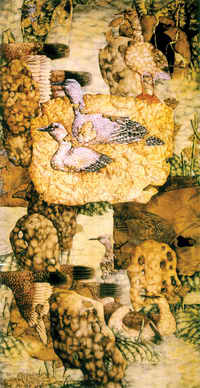| Fragments of Nature |
| http://www.sina.com.cn 2003/05/29 10:44 中国周刊 |
◆Edited by Cynthia and Mingni
Zhang Qing was initially drawn to the bird and flower paintings of the Tang and Song dynasties (7th - l2th centuries). Later, Qing dynasty (l644- 1911) artist Ren Bonian, well known for his paintings of figures, also became an important influence. Although Zhang Qing considers his style to be firmly rooted i1l traditional Chinese painting, he has also been influenced by several western painting techniques such as shading and the various approaches to structure, which lend a unique three - dimensional quality to his work. Indeed, the structure and composition of his paintings are just as important to his art as are the meticulous brushstrokes he employs to create his images. When one views Zhang Qing's art, it is like entering a fantasy world, one dominated by birds, an assortment of flowers, and populated by images of people from China's past. For Zhang Qing, the precise rendering of his subject matter is a true reflection of how ideally man and nature interact. Indeed, since its inception, the essence of bird and flower painting has evolved from the depiction of nature, both exclusively and realistically, to a concentration on man's activities, with nature only serving as a backdrop. but now,said Zhang Qing, people realize tl1at man is not superior to nature. but is an integral part of it. In our world man and nature must share space. Birds often dominate Zhang Qing's works compositionally,swheresthey not only serve as special emblems of nature, but also serve to showcase his skillful brush techniques. I use the jili technique to depict my bird's feathers. This enables me to create very lifelike birds.said the artist. Although the bird feathers are extremely lifelike, the birds themselves are often depicted in static poses, a technique Zhang Qing uses to take the focus off specific bird images and to redirect it to the message he wants to bring to his viewers.The human figures in Zhang Qing's paintings are often stationary, static images as well. They engage in no one specific activity, but are simply props for his imaginative interpretation of nature: a world full of peace, calm, and contemplation. And yet like most contemporary Chinese artists. Zhang Qing is constantly confronted with a fast-changing society. He is concerned with maintaining the essence of China's l,000 year old bird and flower painting tradition, but recognizes that he must also supplement it with the best Western elements merging them with his own unique visions. Ultimately Zhang Qing would like the real world to reflect the one he creates in his paintings - a dream-like realm full of tranquil images of man interacting with nature. Zhang Qing said that through my painting I would like people to understand and appreciate the unique relationship between man and nature.Moreover, after viewing his paintings, Zhang Qing hopes that people will pay more attention to the individual plant, bird or flower, which they encounter in their everyday lives. |
| 【英语学习论坛】【评论】【大 中 小】【打印】【关闭】 |

 Zhang Qing's artistic journey is just as unique as his art. Although he began to paint when he was young, and took classes in this subject during high school, his first professional artistic endeavor was creating designs for Chinese cloisonn enamel pieces, followed by his work as an illustrator for a cartoon design company. It was only after he was acceptedsintosthe Beijing College of Education in 1987 that he first began to study traditional Chinese painting.
Zhang Qing's artistic journey is just as unique as his art. Although he began to paint when he was young, and took classes in this subject during high school, his first professional artistic endeavor was creating designs for Chinese cloisonn enamel pieces, followed by his work as an illustrator for a cartoon design company. It was only after he was acceptedsintosthe Beijing College of Education in 1987 that he first began to study traditional Chinese painting.